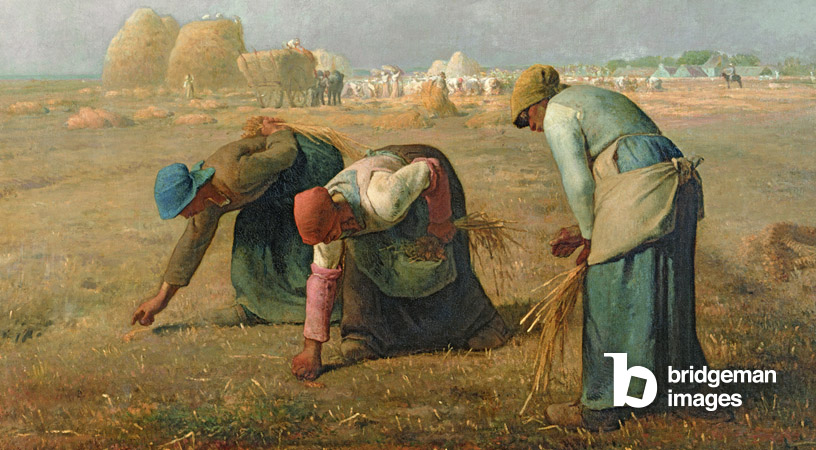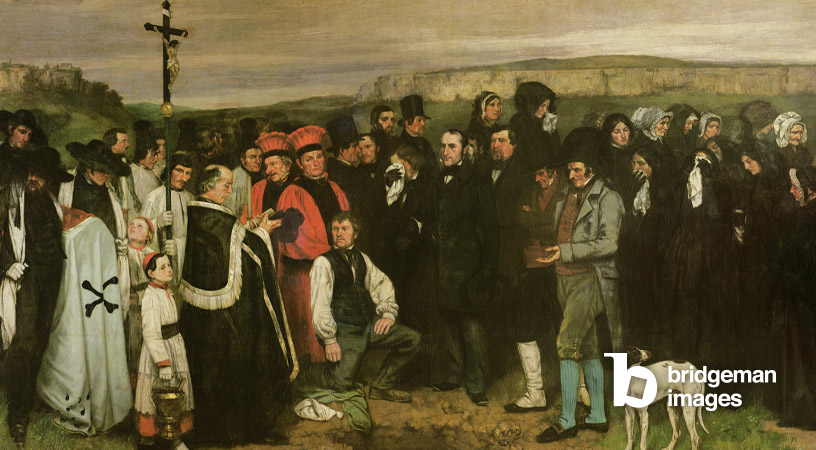Published 25/07/2023
In a literal sense, "realism" refers to an artistic movement of the mid-19th century characterised by subjects painted from everyday life in a naturalistic manner; however, the term is also commonly used to describe works of art painted with an almost photographic likeness.
View our selection of works from the Realism movement
Introduction to Realism
Often when people hear 'realism,' they think of something truthful or factually accurate. Yet in intellectual discourse, realism takes on a spectrum of meanings, steeped in philosophical query and aesthetic theory.
At its core, realism can be defined as an orientation that posits the existence of the objective world - a world external to human thoughts and perceptions. To put it simply, realists believe that what is perceived exists independently irrespective of us perceiving them.
Appreciating the myriad facets of realism starts with recognizing how expansive and influential realism has been throughout history. As we cast our intellectual nets wide across disciplines like art history, literature, philosophy, sociology discourse up until international politics – you’ll find bright threads of realism interwoven meticulously.
In exploring these different strands – from artists striving for their work to reflect life "as it really is" to philosophers wrestling with questions about the nature of reality - we start realizing that differences between types of realities often mark distinct ways societies progress over time.
Embark on this journey through realism’s grand tapestry! Grasp how collective understanding shapes our experiences in every aspect – from painting a piece of artwork to strategizing foreign policies. It’s incredible how one idea intersects so many areas shaping the very fabric of our lives!
Are you prepared for this enlightening trip? Hold tight! This comprehensive dive will guide you step-by-step through each vibrant avenue where 'realine' leaves its indelible mark!
Realism in Art and Literature
Stepping into the effervescent world of art and literature, one can't disregard the noteworthy influence of realism. Essentially, realism is a type of approach that seeks to portray life accurately, without the filters of idealism or romanticization. It's a realistic painting definition that captures every painstaking intricacy around us - every hovered dust particle on an aged wooden table to each crumpled leaf mellowing in autumn.
Realists, as artists are often called in this context, demonstrate not only technical skill but also a deep understanding and acknowledgment of ordinary people's lives. They focus on present circumstances rather than idealistic concepts or emotional excesses.
Unsurprisingly, defining realistic art triggers fascinating conversations - do we consider direct reproductions or empirical representations? Nevertheless, for all its complexities, some common elements thread together diverse forms of realism:
- A commitment to portraying life as it is.
- An emphasis on everyday subjects.
- Fidelity to natural appearances.
Now transitioning from color palettes to typewriters- let's delve into literary circles where much like visual arts - realism opts out narrative frills and dramatic ebbs. Instead, it carves characters with remarkable depth and believability—realism literary definition anchors itself around capturing ordinary humans in their element sensitively.
Indeed, looking at prominent figures such as Gustave Flaubert and Honoré de Balzac emphasizes this dedication to authenticity over storytelling grandeur. Adopting a microscopic lens instead of a kaleidoscope one – these realist writers meticulously craft human experience by drawing fine threads between social settings and personal narratives.
Interestingly though, criticism laced within praises emerges when discussing realism in art and literature—a poignant reminder that appreciation for stark reality imbued artwork varies greatly between individuals.
Ultimately though, love or critique aside- examining any "realism example" undeniably underscores why it has enthralled and perplexed millions. It shines for its uniquely unvarnished mirror to the interpersonal and outer realities that shape our world. Undoubtedly, realism continues to carve a significant trail within the global art and literature landscape whilst prompting insightful contemplation from its spectators.

Realism in Philosophy
Diving into the realm of philosophical thought, realism takes a stand as an intriguing and multifaceted perspective. Defined broadly, realism is the belief that reality exists independent of human perception. It's the foundation on which many debates around ontology and metaphysics are structured, offering fuel for critical questioning and logical investigation.
Let me explain better by detailing what realists believe. Realists place their faith in a world composed of physical entities; they advocate for an external reality existing outside our minds' narrative. As one navigates through different types of realism, it becomes evident that this principle remains at its core - each variation asserting unique correlations with other concepts within philosophy.
Realistic theory asserts that perception alone does not construct reality. Instead, it takes on a non-skeptical realism approach where truths about existence can be discovered and understood objectively. Even when we remain oblivious to certain aspects or perspectives of the cosmos, those details persist regardless of our awareness.
To provide a more concrete understanding here’s an instance: consider an apple tree located in a deserted orchard—inhabited only by flora and fauna—blooming its spring blossoms in silence every passing year. The realistic point of view insists that these events occur irrespective if there's no human observer present to capture them and transcribe them into words or memories.
Philosophers who have enriched the discussion relating to philosophical realism include Immanuel Kant, René Descartes, and Bertrand Russell among many others. Their philosophies underscored three dominant themes revolving around realism:
- Whether categories like 'time', 'space', 'objects' hold separate realities beyond subjective consciousness.
- Acknowledgment of abstract entities such as numbers & sets possessing objective truth.
- Highlighting broad consensus on moral principles suggesting universal moral realities
As you might discern now, attempts at encapsulating realism definition within philosophy results in traversing intellectual labyrinths - it’s indeed an intriguing venture. There exist narrations of realism in philosophy which are complex, provocative and controversial but ultimately vital for well-rounded discourse.
At this point, however, the onus is on you. How do you find yourself correlating with these principles? As a reader stepping into the intellectual arena surrounding realism, where do you see yourself situated amidst these varying dimensions? With room for exploration and articulation of personal perspectives, philosophy always welcomes new insight.
Realism in Politics and International Relations
In the realm of politics and international relations, the concept of realism takes a unique dimension. The primary doctrine that drives this area of study is often referred to as political realism or realistic theory. This perspective holds a particular narrative about global affairs that I'd like to share with you.
Firstly, realists believe power dynamics primarily drive international relations. They tend to view world dealings through a lens marred by mistrust, competition for power, and potential conflicts—essentially echoing Hobbes' sentiment of life being "nasty, brutish and short". However, this doesn't mean realists don't value diplomacy or witness periods of peace—it's just that they are likely more cautious about it.
- The basis for comparison between nations is their relative power rather than any ideological or moral standings.
- States are viewed as pursuing their interests purely on rational terms. Hereby the phrase 'what do realists believe?' might be an oversimplification as differentiating nuances exist within each subgenre.
An illuminating example of realism in action can be seen in how countries approach matters such as defense spending and security alliances. A sharp focus on survival guides these strategic alignments, often ignoring softer issues like human rights violations resulting in pragmatist behavior rather than idealist.
Building upon the foundation set by political theorists such Morgenthau - famed for his six principles of realism - the sphere has grown manifold, giving rise to types of realism including classical realism (primarily focused on human nature), neorealism (focused on structural constraints), and offensive/defensive realism depending on whether states seek power incrementally or rampantly.
Criticism exists too - numerous scholars argue that realism’s cynical worldview can create self-fulfilling prophecies where distrust breeds conflict. Yet no one negates its central role in understanding foreign relationships because time and again historical events have validated its theory.
In essence, neorealism specifically has made profound contributions to shaping the philosophy behind international relations policies worldwide with its academically rigorous approach to predicting state behavior. To sum up, realism helps paint a pragmatic picture of still waters running deep within political scenarios and in many ways, is irreplaceable for deciphering world events.
Next time you come across headlines about realism foreign policy or hear someone mention realism IR (International Relations) - don't forget you are referring to an age-old tradition that continues to shape governments' decisions as they navigate through the complex world around them.
Realism in Film and Media
Realism has undoubtedly found a comfortable home within the realms of film and media. The realistic theory, applied to motion pictures or television, often puts great emphasis on creating stories that mirror our day-to-day lives, exploiting both their mundaneness and their drama.
A perfect realism example would be films like "The Florida Project" or shows such as "The Office." These works strive to depict life just as it happens — rather unpolished, yet filled with emotional subtleties. Moments of humor, sorrow, disappointment, or triumph happen organically without the traditional melodramatic flare we are conditioned to expect from fictional narratives.
When concerning these types of realism:
- Narrative realism holds attention on the story's plausibility
- Cinematic Realism leans towards making visual elements look believable.
In virtual realism - an intriguing type of realism - which is burgeoning with the development of state-of-the-art technology, digital worlds come shockingly close to duplicating our physical reality.
Interestingly enough, this non skeptical realism can challenge our ideas about what constitutes reality. When virtual experiences are so convincingly real that they provoke genuine human emotions ran intense as those elicited by analogous events in real life — doesn't it blur lines? Are those not real feelings? As we journey further into the digital age and continue to refine immersive technologies such as VR (Virtual Reality), AR (Augmented Reality), this philosophical debate will only intensify.
Finally yet importantly it must be noted: while realism aids in immersing viewers completely within a narrative through its grounded nature and authenticity - criticism of realism also endure. For instance, some critiques argue that too much focus on recreating 'reality' might limit creativity or make escapism more difficult for audiences seeking respite away from 'the real world' via visual entertainment mediums.
Despite criticisms though, one thing remains clear: Realism continues to be an integral part of film and media, shaping narratives that resonate with audiences worldwide on a profound, human level. The future holds fresh experiments undoubtedly with realism in the dynamic world of Film and Media with endless possibilities for evolution.
Realism in Economics and Sociology
Permeating disparate disciplines beyond aesthetics and philosophy, realism indeed asserts a significant influence over both economics and sociology. This undeniable impact essentially originates from the ability of realism to offer fundamental analytical tools—ones that facilitate superior understanding of society's structure as well as its multifaceted phenomena.
In this section, we'll explore what do realists believe when it comes to these two distinct fields, focusing particularly on how they perceive and decipher social behavior and economic patterns.
Economic Realism: A Closer Look
At its core, economic realism operates around the recognition of self-interest driving human behavior. This realistic theory posits that individuals or entities operate primarily out of their own benefit, commemorating an inherent pursuit for maximal utility or profit—even at times sacrificing ethical boundaries. An example here illustrates this point aptly—if there are no regulations at place, companies might dispose hazardous waste unsafely to cut down costs.
Likewise, let's look into another aspect—an international relation realism. With reflections on global economics, this scenario depicts nations as individual actors propelled by national interest. Trade policies are designed to envelop more power—economically or otherwise—and sustain or heighten global stature.
Sociological Realism: Unveiling Understanding
Sociologically too, 'realist define' themselves somewhat similarly—they see societal elements not merely as abstract concepts but tangible realities impinging upon human life continuously. Key here is acknowledging the existence of 'social facts' independent from individuals; existing regardless whether anybody perceives them.
This type of realism also identifies inequality—a pivotal sociological concern—as a reflection of prevailing structures built over time through concrete social practices. For instance, gender disparity isn't imagined but manifests through veritable actions within households, workplaces et al., forming established patriarchal structures therein.
Merging the Two: Interplay between Economics and Sociology
Recognizing intersecting points across these disciplines, they're typically studied under the lens of realism—viewed together rather than standalone. Notably, economic decisions impact social aspects and vice versa—a viewpoint encompassing both micro (individual) and macro (societal) facets.
In short, from defining societal structures to exploring economic motivations—the course a society takes is substantially framed through its real-world implications, which serves as the basis of any realistic theory. Thusly defined, it forms the root of analytical approaches in both fields. Herein lies the true strength of realism—it grounds us in reality while examining complex socio-economic phenomena.

Implications and Future Directions
As we ponder the intricate facets of realism, it brings us to an exploration of its potential consequences and forthcoming trajectories. It becomes clear that this fundamental concept isn’t bound by discipline or era—it encompasses art, literature, philosophy, politics, film, media, economics and sociology.
Firstly, let’s delve into the implications. Realist define their approach as a reflection of reality which holds several meaningful impacts across various fields. The 'what do realist believe' aspect directs a challenging inquiry towards our own assumptions about truth and objectivity.
From an international relation realism perspective, the mainstay of countries following self-interest can help outline future strategic policies that co-exist alongside global collaborations - foreshadowing the adoption of a more practical attitude to maintain peaceful relations among nations. Realism foreign policy implies pragmatic decisions based on national interest rather than ideals or moral considerations.
In light of criticism of realism in arts or literature exposes suspension points between authenticity and artistic liberty. Artists grapple with how to depict reality without losing their individual interpretation - striking a balance could potentially shape the course for revolutionary creative movements in future.
Thriving within philosophy's realm is non skeptical realism.It predicates upon belief in an external world independent from human perception- further musing over such conceptual complexities profoundly impact our existential comprehension.
Moreover, brainstorming realistic theory also carries significant clues for technological advancements – particularly in realms where virtual realism takes center stage. The merger between real and virtual worlds heralded by augmented reality (AR) technologies may fundamentally transform digital interfaces encounter.
Be it the morgenthau six principles of realism guiding political decisions or planning economic strategies considering ground realities; indications point toward continuously toeing realist lines even as we evolve.Our path forward appears firmly rooted in dealing with problems realistically while seeking adaptable solutions rather than pursuing utopic ideals.
All considered trends nevertheless encompass both enlightening prospects along steeper pitfalls awaiting due attention even as we step into a future skimming through the surfaces of realism’s vast riverbed, waiting to unearth promising pebbles enriching tomorrow's landscape with newfound understanding and perspective.

Conclusion
After traversing the vast field of realism together, unwind by taking a moment to delve into our final reflections. Indeed, it's evident that realism is an all-encompassing doctrine, like a wide canvas painted with diverse colors from art to philosophy and politics to economics.
Surely you've noticed the impressive pedigree of thinkers who have contributed to this theory: philosophers seeking the fabric of reality, realist painters capturing life in its most profound moments, authors penning tales steeped in societal truths, and scholars unraveling the mechanics of world affairs—all under the umbrella of realism. These are just a few examples that demonstrate how pervasive the concept is across different avenues.
Perhaps what stands out about realism—be it political realism or any type—is its raw honesty and groundedness. It presents unadulterated truths without sugarcoating facts or situations. The keyword for realists resonates deeply here: they believe in seeing things as they are, not as we want them to be.

In addition, there’s no ignoring criticism of the idea every so often—for example when looking at virtual reality—a form of modified realism—that challenges traditional perceptions. This shift doesn't diminish the essence or value of original ideas but rather underlines how adapting works equally important for knowledge evolution.
Moreover, within international relations (IR), Morgenthau's six principles provide a lens through which we understand power dynamics on the global stage—an indispensable framework in our rapidly changing world.
However, despite numerous theoretical perspectives and several slices in between idealism versus non-skeptical realism among others being carved up now and again—the forceful stream of realism continues forward unscathed - perhaps depicted best via changes in media portrayal over time.
Lastly but significantly—realism isn’t stagnant; instead it carries longevity because it continually evolves—it learns and grows from society while simultaneously influencing it back. With emerging platforms—like augmented reality—we might witness further amplification or alteration of realism's fundamental rules in coming years.
Yet, no matter how much progress we make, the basic understanding fostered by realism—keeping us rooted to ground realities while allowing space for perspectives—will forever remain relevant. The immense respect and acceptance spanning centuries surely testifies to that.
So as we leave this exploration behind, remember how valuable an understanding of realism is—a tool with which you can navigate multifaceted aspects of life and world around. And most importantly—it underlines a pursuit towards truth—a voyage that infinitely continues.
View our selection of works from the Realism movement
Get in touch with our team; we are always happy to assist you with your inquiries, with no obligation or additional cost.


